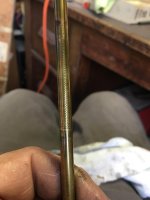I imagine the question applies to the rest of the larger Ellisons as well.
You know how, with Wal-Mart carburetors when you push them to full throttle it opens up a special circuit to squirt some extra gas into the intake manifold so as to cool the cylinders when under such high-temperature operation? Gas being used (wasted) as a coolant. Using full mixture rich also helps with this situation although the ordinary carbs have an extra special circuit that only kicks in when the throttle is pushed fully forward and (I'm assuming . . . mixture is fully rich . . . but am not sure about this).
I may be not asking this question very clearly, reading the above. Honing it down to the bare essentials, do the Ellisons have an "extra fuel circuit" that kicks in only when the throttle is pushed fully in? I've been operating mine as if it didn't/doesn't have any provision for squirting extra fuel into the manifold when throttle is fully open and mixture fully rich.
Instead, when landing for fuel in the midwest with it's 115° on the ramp, middle of July or August, I will use full power until I'm high enough to turn around safely then pull back the throttle a little bit and from then on, until reaching altitude, doing the power vs mixture dance while slowly climbing up to where it's cool.
Thinking about this for some reason today . . . does the Ellison have that extra squirt circuit for full throttle operation . . . used for keeping cylinder temperatures under control at full throttle operation?
If so . . . does the mixture control disable it? Once at altitude and oil temperatures have dropped back to where they should be, throttle is again opened to full and mixture pulled back to as lean as possible while still running smooth. What stimulates this question is, at altitude my throttle is always fully open . . . which may affect that cooling circuit (if it has one).
Any thoughts on this by anyone? Thanks.
You know how, with Wal-Mart carburetors when you push them to full throttle it opens up a special circuit to squirt some extra gas into the intake manifold so as to cool the cylinders when under such high-temperature operation? Gas being used (wasted) as a coolant. Using full mixture rich also helps with this situation although the ordinary carbs have an extra special circuit that only kicks in when the throttle is pushed fully forward and (I'm assuming . . . mixture is fully rich . . . but am not sure about this).
I may be not asking this question very clearly, reading the above. Honing it down to the bare essentials, do the Ellisons have an "extra fuel circuit" that kicks in only when the throttle is pushed fully in? I've been operating mine as if it didn't/doesn't have any provision for squirting extra fuel into the manifold when throttle is fully open and mixture fully rich.
Instead, when landing for fuel in the midwest with it's 115° on the ramp, middle of July or August, I will use full power until I'm high enough to turn around safely then pull back the throttle a little bit and from then on, until reaching altitude, doing the power vs mixture dance while slowly climbing up to where it's cool.
Thinking about this for some reason today . . . does the Ellison have that extra squirt circuit for full throttle operation . . . used for keeping cylinder temperatures under control at full throttle operation?
If so . . . does the mixture control disable it? Once at altitude and oil temperatures have dropped back to where they should be, throttle is again opened to full and mixture pulled back to as lean as possible while still running smooth. What stimulates this question is, at altitude my throttle is always fully open . . . which may affect that cooling circuit (if it has one).
Any thoughts on this by anyone? Thanks.





